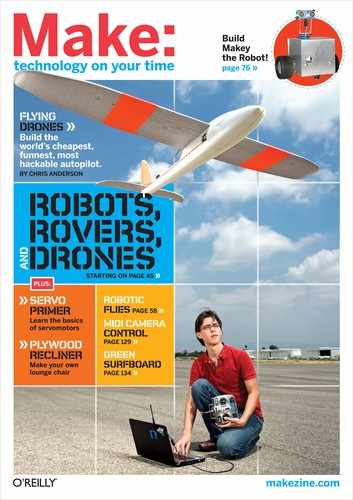WELCOME BY MARK FRAUENFELDER
Surprising Robots
Don’t get me wrong — I enjoy the spectacle of a noisy, violent robot war as much as the next person. I love it when sparks fly and screaming circular blades tear into the metal hide of smoke-belching battle bots. It’s thrilling to watch one bot ram another and send it flying into the bulletproof plexiglass separating the spectators from the combat arena.
But as much as I like battle bots, and as much as I admire the clever and resourceful enthusiasts who make them, I don’t consider these machines to be true robots. Like many crawling and rolling mechanical critters given the label “robot,” battle bots are really just remote control vehicles, albeit armored and weaponized ones.
To me, a real robot is one that can “think” for itself, to have a degree of autonomy. In fact, the first use of robot was in a 1921 play by Karel Capek called R.U.R. (Rossum’s Universal Robots) that featured intelligent androids nearly indistinguishable from human beings.
What does it mean to say a machine is autonomous? I can’t think of a better explanation than the one offered by W. Grey Walter, the colorful robot pioneer of the mid-20th century. In his 1953 book, The Living Brain, Walter wrote that in order for a machine to demonstrate a “fair imitation” of cerebral activity it must have “some measure” of the following attributes: “exploration, curiosity, free-will in the sense of unpredictability, goal-seeking, self-regulation, avoidance of dilemmas, foresight, memory, learning, forgetting, association of ideas, form recognition, and the elements of social accommodation.” Simply put, a machine that behaves this way is surprising, fascinating, and a terrific challenge to build.
It was especially terrific in Walter’s day, given the level of electronics technology he had to work with, but that didn’t stop him from designing and building electromechanical “turtles” with two “brain cells” that exhibited at least a few of the above attributes. In this volume of MAKE, senior editor Gareth Branwyn reveals the little-known true story of Walter and his robotic turtles.
Walter’s dream lives on today, more than 50 years later. Our own MAKE intern Kris Magri designed and built an autonomous robot that could be considered the great-grandchild of Walter’s turtles. Her article shows you how to build a Makey of your own that will follow you around the room.

Build a Makey the Robot of your own that will follow you around the room.
Not all autonomous robots are wheeled or legged. Some fly. Our cover story, by Wired editor-in-chief Chris Anderson, explains how he and his fellow drone enthusiasts have developed inexpensive autopilots for remote control planes. I witnessed history in the making in April when Anderson’s flying drone won the first Autonomous Vehicle Competition in Boulder, Colo. My account of the event is also in this issue.
But this issue of MAKE has more than just robots. We’ve got a fire piston, a speed vest, a servo primer, and a boombox made from paper cups. If you want to read this issue in style, why not first build the Rok-Bak recliner, designed by Larry Cotton. I had the opportunity to give this comfortable plywood chair a test drive at this year’s Maker Faire in San Mateo, and the only thing that could coax me out of it was the lure of a cup of John Park’s vacuum-made Florence Siphon coffee (which he presented in MAKE, Volume 17).
Here’s hoping your fall is filled with the sweet sounds of making.
Mark Frauenfelder is editor-in-chief of MAKE.
Making Your Way in an Uncertain Economy

“We have chosen not to participate in the current recession.”
Glen Kadelbach, GR Kreations
Glen Kadelbach’s life as a Maker began at seven years of age - long before he was a ShopBotter - when his grandfather gave him a hammer and a hand saw. Life on a farm offered many opportunities to fix and make things - like barns and gates - and as he grew, so did his interest in making. He began to make props when recruited by his photographer sister to help with her sets, and in 2002 he incorporated his first business, GR Kreations, Inc. Glen purchased his ShopBot in 2007 and added Vectric’s Aspire 3D software to his Maker arsenal in 2008. He still makes photo props, but now his work also includes anything he and his customers can dream up. Today, Glen runs four businesses and uses his ShopBot to make things from whatever materials he can get his hands on - wood, plastic, foam, even cardboard. Glen’s love for making continues to grow along with his businesses.

ShopBot Buddy
“I feel really good about my shop and the technology that I have. Owning a ShopBot along with Vectric’s Aspire has opened up so many doors and has shown me so much opportunity. I would not want to be without either. Business for me is great. We have chosen not to participate in the current recession.”
Call or visit us online to learn how a ShopBot can help you make the things you want to make.

888-680-4466
www.shopbottools.com
